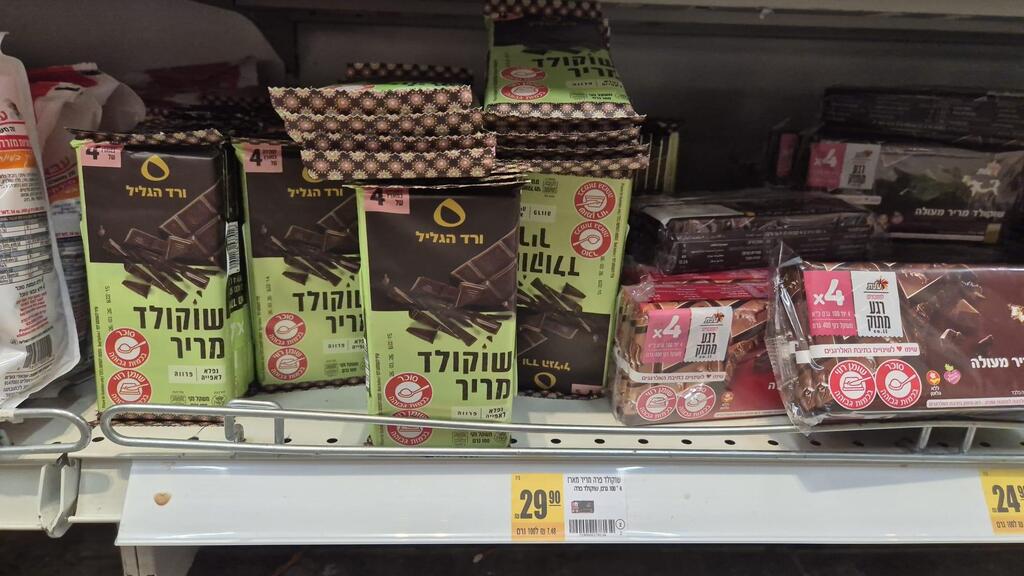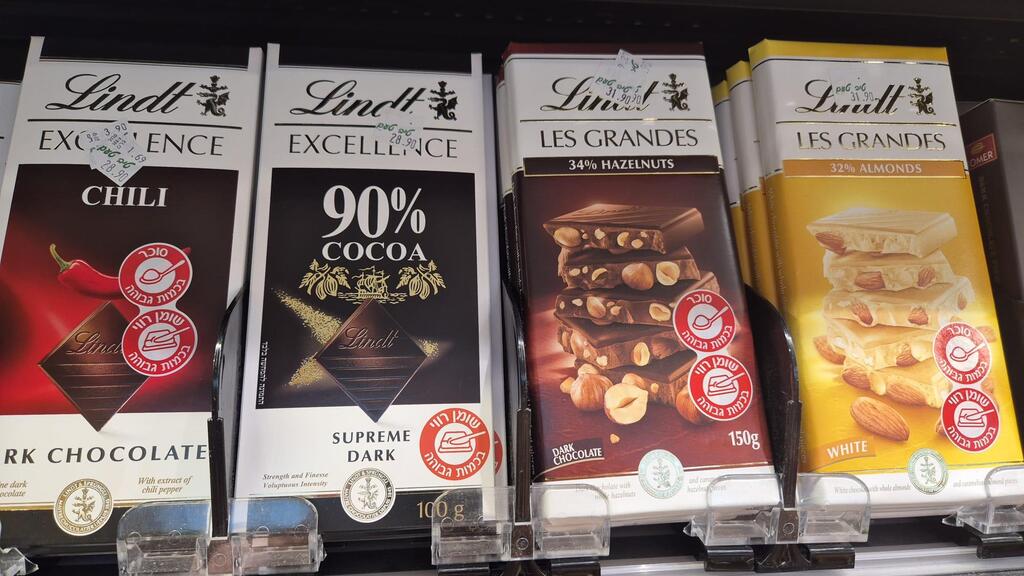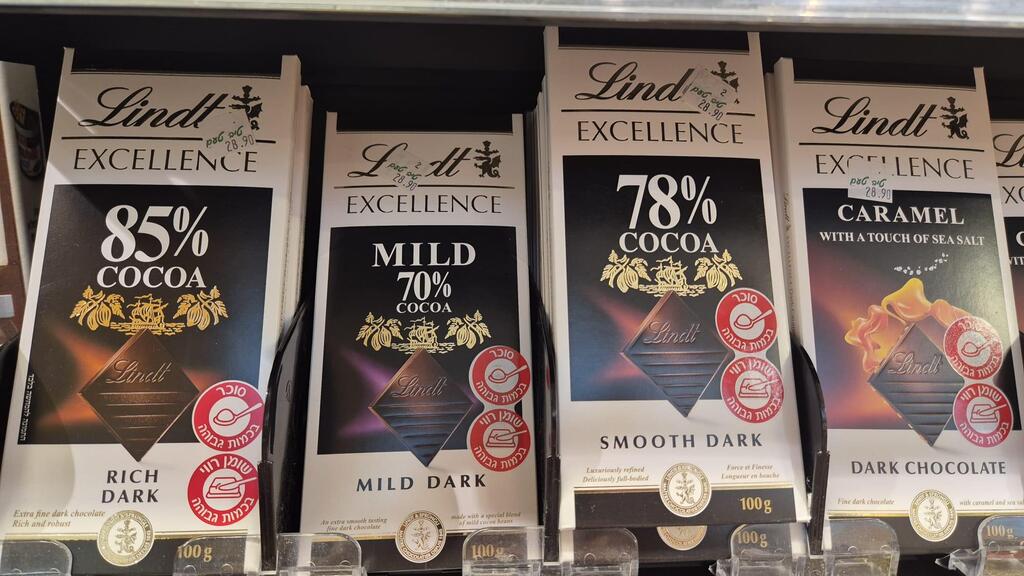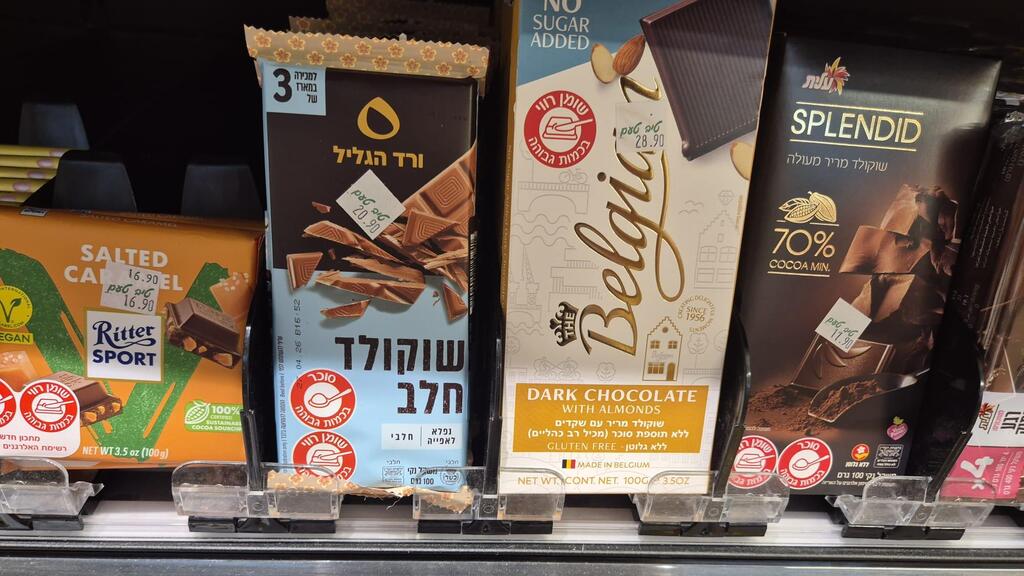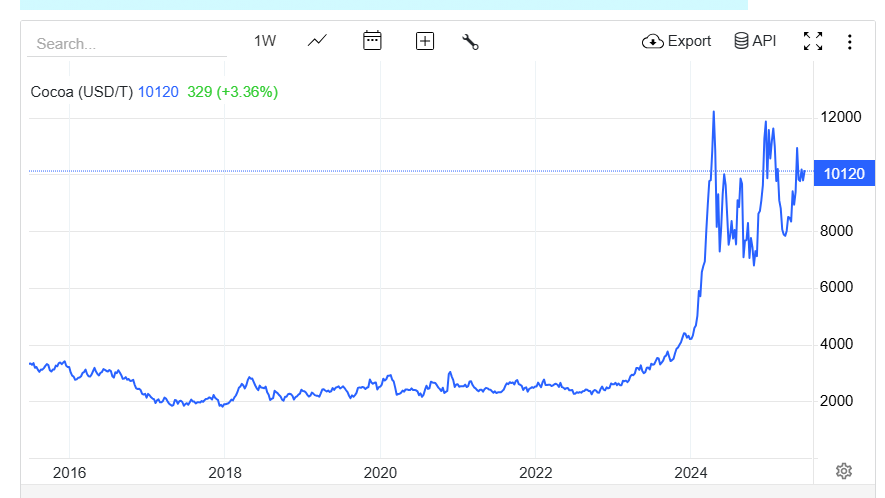How much have you paid for chocolate recently? One of the staple items in the Israeli shopping basket has risen dramatically in price over the past two years, and it’s not over: after the price hikes announced by Strauss just before the war, which will go into effect in July, the price of a “Red Cow” chocolate bar is expected to rise by another 15.8%.
Let’s take, for example, the low price for a Red Cow chocolate bar. At Rami Levy, it is currently sold for 7.90 shekels ($2.33). That price is expected to rise to 9 shekels ($2.65)—and cost 7.5 shekels ($2.21) during sales. A year ago, the same bar sold at many chains for $1.92, and on sale for 4–4.5 shekels ($1.18-$1.33). That represents an unbelievable increase of 50% within a year in consumer promotional prices.
7 View gallery
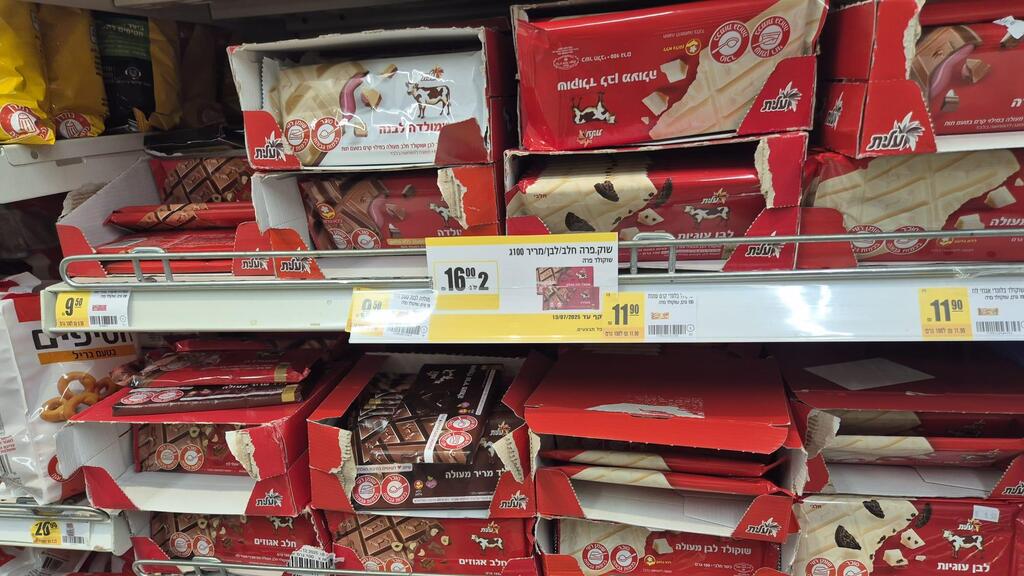

How much have you paid for chocolate recently? Israel's classic Red Cow chocolates
(Photo: Meirav Crystal)
According to a comparison using the "Prices" comparison website, we can see the steep price increase of this popular mass-market chocolate: In May 2023, the price of a 100g Red Cow milk chocolate with rice crisps at Shufersal Deal was 5.90 shekels ($1.74), and on sale 4.50 shekels ($1.33). In May 2025 the price had climbed to 8.40 shekels ($2.48), and on sale to 7.50 shekels ($2.21)—that’s a 67% increase. Now, after Strauss’ announcement, another increase is expected.
At Yochananof, Red Cow chocolate that sold for 5.90 shekels ($1.74) or 5 shekels ($1.47) on sale has risen in two years by 40% to 7.90 shekels ($2.33) and 7 shekels ($2.06) on sale—and, as noted, the price will go up further. The price of its competitor Milka Oreo 100g milk chocolate also rose from 6.90 shekels ($2.03) to 9.90 shekels ($2.92), an extreme 44% increase.
What about other cheap chocolates? A check shows that Vered HaGalil brand chocolate also became more expensive. A three-pack of 100g dark chocolate bars, usually used for baking, rose at Victory from 14.90 shekels ($4.39) to 22.90 shekels ($6.75)—an increase of 54%. At Carrefour Hyper, it increased by 9%, from 17.30 shekels ($5.10) to 18.90 shekels ($5.57).
The three-pack of Chocketa 60% dark chocolate rose at Yochananof by 14 shekels ($4.13) from 12.90 shekels ($3.80) to 26.90 shekels ($7.93)—an increase of 108.5%. At Victory, the item rose by 13 shekels ($3.83) from 13.90 shekels ($4.10) to 26.90 shekels ($7.93)— a 93.5% increase.
And what’s even more extreme? The price of Lindt chocolate in Israel. Lindt is a premium Swiss brand—arguably the finest chocolate sold in Israeli supermarkets—but the current price may have exceeded consumer tolerance: a 100g bar of Lindor Excellence, which sold a year ago for 13 shekels ($3.83)–19 shekels ($5.60), is now sold for 20 shekels ($5.89)–30 shekels ($8.84) without a promotion. Yes, that's the supermarket price per 100g—an extremely steep increase.
Lindt’s price also jumped massively at cheaper chains: in May 2023, a 90% cocoa Lindt Excellence bar cost 14.90 shekels ($4.39)at Rami Levy and is now 22.70 shekels ($6.69)—a 52% increase. At Victory, it was 15.90 shekels ($4.69) and is now 22.90 shekels ($6.75), a 44% increase. At Carrefour Hyper, 14.90 shekels ($4.39) to 22.90 shekels ($6.75)— a 53% rise.
And it isn't just fine dark chocolate that is affected: the 150g milk chocolate bar with hazelnuts Les Grandes by Lindt jumped at Rami Levy by 50%, from 19.90 shekels ($5.86) to 29.90 ($8.81) shekels. At Carrefour City it jumped by 60%, from 24.90 shekels ($7.34) to 39.90 shekels ($11.76). Yes, 40 shekels for a chocolate bar.
Another price increase for Lindt soon? Price in Germany is much lower than in Israel.
When Lindt’s importer announced a 30% price hike at the end of January, it admitted that such increases didn’t exist elsewhere in the food world—and it’s not over. Lindt Global plans another price surge, and retailers are preparing for it in Israel.
These are insane prices—especially given that in Germany, where Lindt also got more expensive, the price is 3.99 euro (about 16.5 shekels), versus 40%–100% more in Israel, compared to 2.99 euro (12 shekels) a year ago. In Israel you now see more promotions on the brand—and it’s best to buy only during sales, otherwise leave it on the shelf, no matter how sad it makes you.
Of course, if Lindt and Red Cow rose in price, other brands did too. Ritter Sport rose by tens of percents and Kinder products by nearly 20%, and only Strauss’s Splendid hasn’t risen yet.Tony’s Chocolonely chocolate hasn’t yet risen in some chains.
In the past there were cheap private chocolate brands, some from Switzerland and others from Turkey. They disappeared, and today chains import mostly premium competitors.
The reason for these increases: cocoa prices surged after years of stability
Chocolatier Oded Saida recently caused a small stir when he began selling a spelt pita topped with Valrhona chocolate (180g) for 82 shekels ($24.16). True, it’s a spelt pita toasted and broiled with ingredients like real vanilla, honey, olive oil and Atlantic sea salt—but the most expensive component here (besides rent, labor, talent, etc.) is the coating: 70% Valrhona chocolate.
There's a common reason behind these outrageous prices for Lindt and the chocolate pita—and a reason for the sticker shock of Red Cow chocolate: an average 167% rise in cocoa prices within two years, peaking in April and December 2024 at $12,646 per metric ton—almost six times the price of five years earlier. Currently the price has dropped to about $9,800. That's a decrease, but a modest one, and prices remain high. For comparison, between 2016 and 2023 cocoa prices ranged between $2,000 and $3,600. In other words, prices were stable for years—and then suddenly in 2024 skyrocketed.
This happened due to bad weather in major cocoa-growing regions in West Africa—especially Ivory Coast and Ghana (which produce 60% of the world's cocoa)—and a spread of swollen-shoot virus, which causes stem swelling, yield loss, and often plant death. The result: a 14% drop in production from 2023 to 2024.
Price increases also globally: 'Good chocolate is returning to being a luxury item'
Globally, discussions about soaring cocoa prices began among consumers last Valentine’s Day, when CNN reported that chocolate prices rose by 20%. In the UK, Easter eggs filled with Dubai-style chocolates (pistachio cream and kadaif threads) sold for nearly 300 shekels ($88).
In its 2024 annual report, Swiss chocolate maker Lindt described it as “a challenging year characterized by record-high cocoa costs, significant price increases, and weakened consumer sentiment.” The company stated not only that it raised its prices, but also that it expects the trend to continue into 2025.
In the U.S., Hershey noted that it buys cocoa nearly a year in advance, so this year’s Valentine’s Day pricing didn’t reflect current cocoa market prices—hinting that prices will rise next year.
Globally, various substitutes are already being explored—like carob chocolate, which is popular in Israel; other plant-based substitutes; and even a U.S. startup aiming to produce lab-grown chocolate.
Get the Ynetnews app on your smartphone: Google Play: https://bit.ly/4eJ37pE | Apple App Store: https://bit.ly/3ZL7iNv
Cocoa has increasingly been viewed as a healthy plant, and healthy chocolate is now sometimes considered a health food. It’s found new uses beyond sweets—for example, in the UK they sell cocoa water with electrolytes and antioxidants.
Michal Paris-Hulam, a Danish artisanal chocolatier, told France 24 that prices of premium cocoa haven’t changed compared to cheaper cocoa. In her opinion, the price is appropriate because it reflects the quality of the product. “It’s good for farmers and the market, and brings chocolate back to its status as a luxury product, because that’s what it is. When people don’t want to pay, they’ll get something that’s not so good.”


